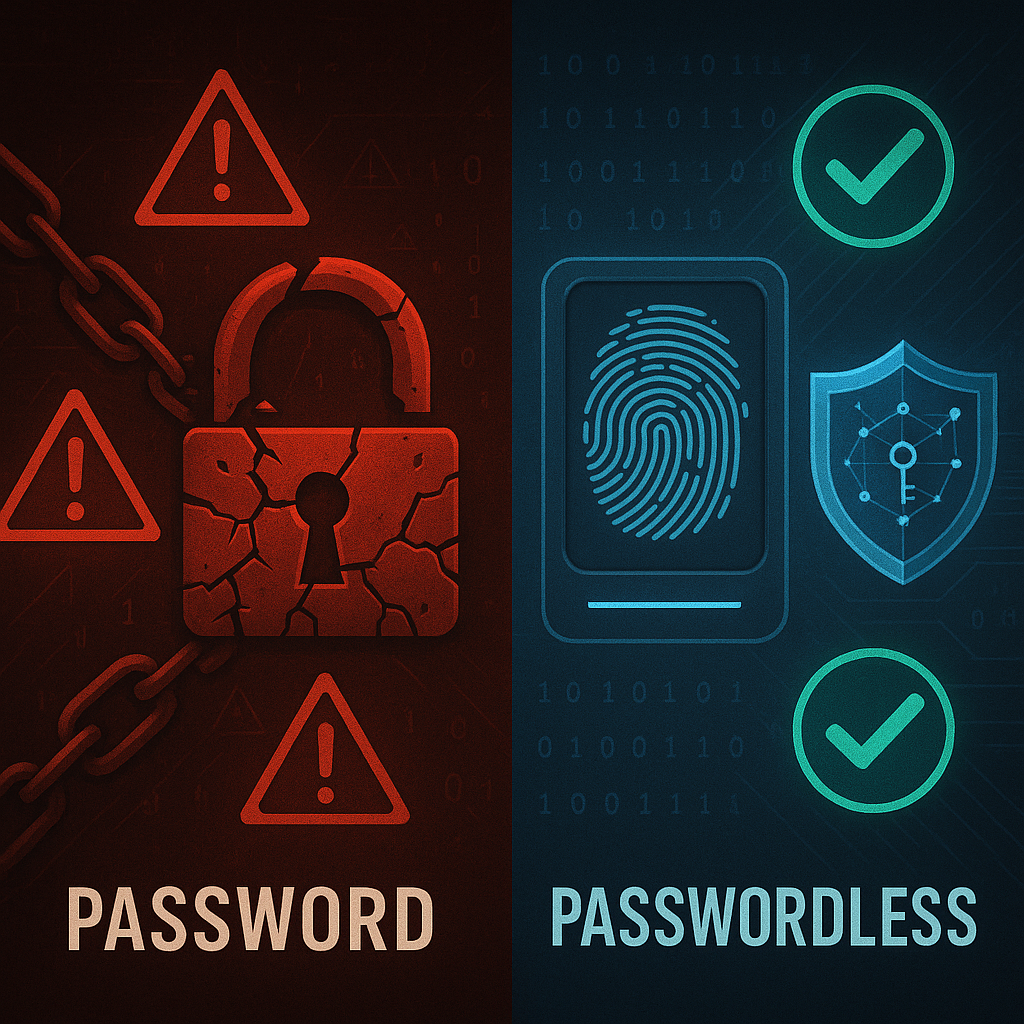Your passwords are everywhere: What the massive 16 billion login leak means for you
Security researchers discovered 16 billion stolen passwords from Apple, Google, Facebook and more. Unlike traditional hacks, malicious software infected millions of personal devices, secretly stealing every login. Here's what this means for your accounts and how to protect yourself immediately.

If you've ever wondered whether your personal accounts are truly safe online, the answer just became uncomfortably clear. Security researchers have discovered something that should concern every person who uses the internet: 16 billion stolen login credentials floating around in databases that cybercriminals can access and use.
To put this staggering number in perspective, imagine that every person on Earth had their personal login information stolen twice over. That's essentially what we're dealing with in what experts are calling one of the largest credential exposures in internet history.
Here's what makes this situation different from other data breaches you might have heard about. Major companies like Apple, Google, Facebook, and thousands of others weren't directly hacked. Instead, something more insidious happened: malicious software infected millions of personal computers, smartphones, and tablets worldwide, secretly stealing every password, login, and credential stored on those devices.
Think of it this way - rather than robbers breaking into a bank's vault, millions of invisible pickpockets have been quietly stealing wallets from people walking down the street. These digital pickpockets, called "infostealer malware," have been harvesting personal information from everyday devices and selling it to cybercriminals who can now use your accounts as if they were you.
What makes this incident particularly alarming is that it represents the weaponization of individual device compromise at industrial scale. Rather than sophisticated infrastructure attacks against corporate systems, cybercriminals have democratized credential theft through mass malware distribution, fundamentally changing the threat landscape for every organization relying on password-based authentication.
Scale and sophistication reveal systemic authentication failure
The numbers tell a sobering story about the evolution of credential theft. From the 32 million passwords in the original 2009 RockYou breach to today's 16 billion credential exposure, we've witnessed exponential growth that mirrors the expansion of our digital attack surface. The 2024 "Mother of All Breaches" contained 26 billion records, while RockYou2024 compiled 9.9 billion passwords—all precursors to this latest incident.
This 16 billion credential exposure contains primarily fresh data harvested through infostealer malware, not recycled from previous breaches. The largest single dataset contains 3.5 billion records focused on Portuguese-speaking populations, while another holds 455 million Russian Federation-related credentials. These databases were structured in the typical format of infostealer logs: URL + login credentials + passwords, often including session cookies and authentication tokens.
The exposure mechanism reveals sophisticated criminal infrastructure. Databases were temporarily accessible through misconfigured cloud storage and Elasticsearch instances—long enough for researchers to discover them, but brief enough to obscure their controllers. This suggests organized operations with advanced operational security, not opportunistic attacks.
Critically, no direct corporate breaches occurred at Apple, Google, Facebook, or other major platforms. As Diachenko clarified, "There was no centralized data breach at any of these companies." Instead, credentials were harvested from individual devices infected with infostealer malware like Lumma, RedLine, and StealC, which have infected an estimated 500 million devices globally in 2023 alone.
Infostealer malware transforms credential theft into mass production
The technical sophistication of modern infostealer operations represents a paradigm shift in cybercrime economics. These lightweight programs operate as multi-payload systems that extract not just saved passwords, but session cookies, authentication tokens, cryptocurrency wallets, and even screen captures during sensitive operations.
Advanced infostealer techniques include:
- Browser session hijacking that steals active authentication cookies, enabling persistent access without passwords
- DPAPI exploitation that decrypts Windows-stored credentials using system-specific APIs
- Real-time keylogging capturing credentials as users type them
- Man-in-the-browser attacks injecting malicious code directly into browser processes
- Clipboard manipulation replacing cryptocurrency addresses and passwords during copy operations
Distribution occurs through sophisticated social engineering: malvertising on legitimate websites, infected "free" software versions, phishing campaigns, and drive-by downloads exploiting browser vulnerabilities. Once infected, devices become persistent credential harvesting platforms.
The criminal ecosystem has evolved into specialized roles: Initial Access Brokers acquire and sell credentials, money launderers convert stolen assets, and technical specialists provide tools and infrastructure. Credentials sell for $10-120 depending on account type, creating profitable business models even with credential stuffing success rates of just 0.1-4%.
Enterprise impact extends beyond individual account compromise
While no direct corporate system breaches occurred, the implications for enterprise security are profound. Government credentials from 29 countries, defense contractors including Pentagon and Lockheed Martin accounts, and Fortune 500 company credentials create significant national security and corporate espionage risks.
The structured format of exposed data—containing specific login URLs for targeted platforms—enables sophisticated credential stuffing attacks that bypass traditional security measures. Even a 0.1% success rate across 16 billion credentials would compromise 16 million accounts, providing attackers with massive potential for lateral movement within corporate networks.
Healthcare platforms, banking systems, and critical infrastructure credentials in these databases enable targeted attacks against high-value systems. Unlike previous breach compilations that contained mostly consumer accounts, this exposure includes significant concentrations of enterprise and government credentials that could facilitate advanced persistent threat campaigns.
Session cookies and authentication tokens in the datasets create persistent access opportunities that bypass multi-factor authentication. Attackers can use stolen session tokens to maintain access without triggering security alerts, effectively creating backdoors into authenticated systems.
The geographic concentration of datasets—particularly the 3.5 billion Portuguese-speaking and 455 million Russian Federation records—suggests targeted intelligence gathering operations that extend beyond simple financial fraud into potential state-sponsored activities.
Industry response reveals dangerous authentication dependency
The muted response from major technology companies highlights a critical gap in breach communication and responsibility. Despite credentials from Apple, Google, Facebook, and Microsoft appearing in the databases, these companies have provided minimal public statements about impact or specific user protection measures.
Google recommended transition to passkeys as password replacement and enhanced Password Manager breach notification features, while continuing to push two-factor authentication adoption. Apple maintained silence on the specific breach while promoting passwordless authentication technology. This disconnect between the scale of credential exposure and corporate response suggests inadequate incident communication protocols.
Cybersecurity experts have been more direct in their assessments. Vilius Petkauskas from Cybernews characterized the exposure as "not just a leak—it's a blueprint for mass exploitation" containing "fresh, weaponizable intelligence at scale." Chris Rader from Rader Solutions noted the unprecedented magnitude: "We've never had a data breach of this size, of this magnitude."
The industry's focus on promoting passwordless alternatives while maintaining relative silence about specific breach impacts reflects a broader challenge: enterprises remain heavily dependent on password-based authentication despite clear evidence of its fundamental vulnerability.
Advanced protection requires comprehensive security architecture transformation
Traditional password security measures prove inadequate against industrial-scale credential harvesting. Organizations must implement comprehensive defense strategies that assume credential compromise and build resilient authentication architectures.

Immediate enterprise actions include mandatory password changes across all systems, universal multi-factor authentication deployment, and continuous dark web monitoring for credential exposure. However, these reactive measures address symptoms rather than the fundamental authentication vulnerability.
Long-term security transformation requires adopting passwordless authentication where feasible, implementing zero-trust architecture with continuous verification, and deploying behavioral analytics for anomalous authentication detection. Organizations must treat password-based authentication as fundamentally compromised and build security models that maintain effectiveness even when credentials are exposed.
The NIST Cybersecurity Framework 2.0 provides structured guidance for comprehensive credential protection across six core functions: Govern, Identify, Protect, Detect, Respond, and Recover. Implementation requires executive commitment and significant investment in identity and access management platforms, typically ranging from $50,000-$500,000 annually for enterprise deployments.
Zero trust implementation becomes critical, with software-defined perimeters replacing traditional VPNs, identity-aware proxy services controlling application access, and continuous trust evaluation throughout user sessions. This architecture maintains security effectiveness even when credentials are compromised, limiting attackers' ability to move laterally within networks.
Regulatory implications demand enhanced compliance frameworks
Current data breach notification laws prove inadequate for addressing infostealer-based credential theft. While states like Wyoming, California, and Florida now require notification for username/password breaches, the distributed nature of infostealer infections creates complex attribution and notification challenges.
GDPR implications include 72-hour breach notification requirements and potential fines for inadequate data protection measures. However, the cross-border nature of the exposure—affecting government systems in 29 countries—complicates jurisdictional issues and creates regulatory uncertainty.
Organizations face shared responsibility model confusion in cloud environments, where they may be liable for employee device compromises that lead to corporate credential exposure. Insurance implications remain unclear for infostealer-related breaches, potentially leaving organizations without coverage for significant remediation costs.
The incident accelerates discussions around enhanced disclosure requirements and expansion of "personal information" definitions in breach laws. International cooperation on cybercrime prosecution becomes essential as credential theft operations increasingly cross national boundaries.
Conclusion: The authentication revolution cannot wait
This 16 billion credential exposure represents more than a cybersecurity incident—it's proof that password-based authentication has fundamentally failed at internet scale. Organizations continuing to rely primarily on passwords face inevitable compromise in an environment where 500 million devices are infected with credential-stealing malware.
The path forward requires immediate tactical responses—password changes, MFA deployment, credential monitoring—combined with strategic transformation toward passwordless authentication architectures. Zero trust principles, continuous verification, and behavioral analytics become essential components of resilient identity systems.
Enterprise leaders must recognize that credential theft has evolved from sophisticated infrastructure attacks to mass production operations targeting individual devices. Traditional security measures designed for perimeter defense prove inadequate against threats that originate from within trusted networks through compromised employee devices.
The cybersecurity community's response to this incident will determine whether we continue reactive approaches to credential compromise or finally commit to the authentication revolution that technology advances have made possible. The 16 billion exposed credentials provide undeniable evidence that the time for incremental password security improvements has passed—comprehensive authentication transformation is no longer optional, but essential for organizational survival in an interconnected digital economy.

